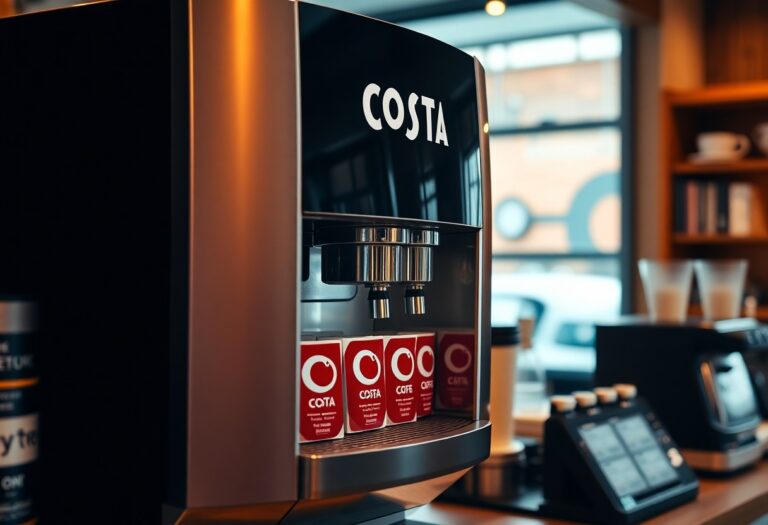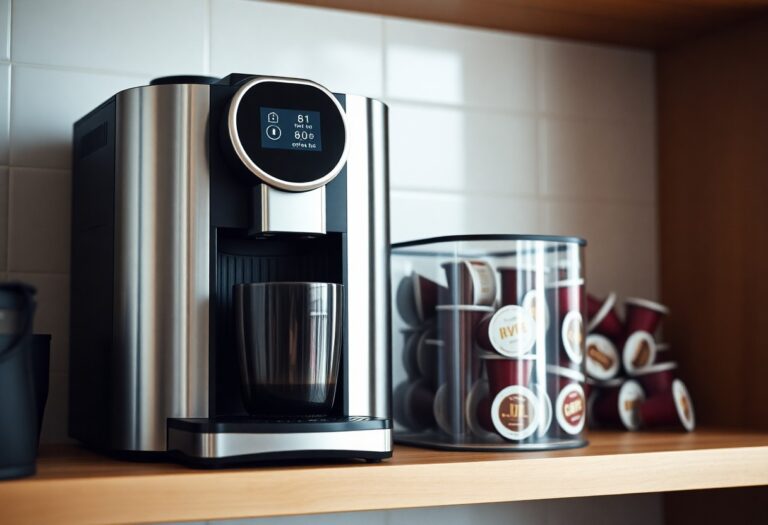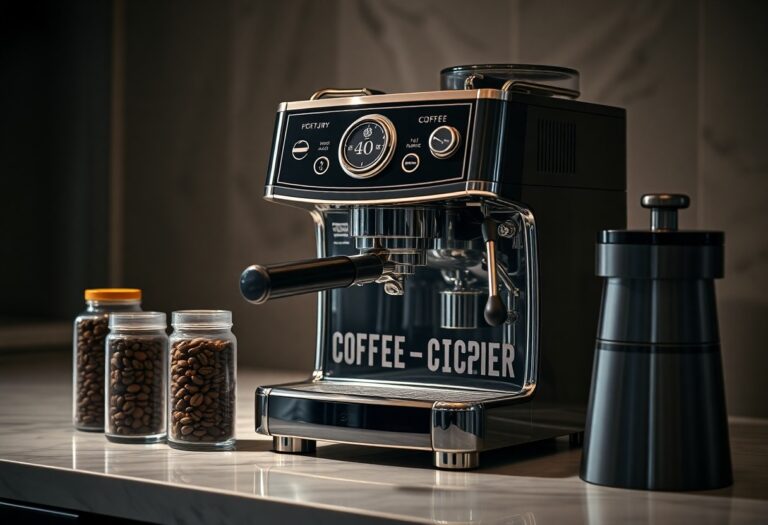What is a Knock Box on a Coffee Machine – Waste Management
It’s imperative to understand what a knock box is when it comes to managing waste in your coffee-making routine. A knock box is a container designed for you to dispose of spent coffee grounds from your espresso machine. By using this tool, you can effectively minimize mess and promote environmentally friendly practices in your kitchen or café. Not only does it help keep your workspace tidy, but it also allows for easy disposal of organic waste that can be composted, making it a positive step towards sustainability.
Key Takeaways:
- A knock box is a container designed to collect used coffee grounds efficiently, often used in café settings and home espresso setups.
- Its primary function is to provide a designated area to dispose of spent coffee pucks after extraction, helping to maintain cleanliness and organization during brewing.
- Knock boxes typically feature a sturdy construction and a cushioned or rubberized bar for easy and silent knocking out of grounds without damaging the espresso machine.
- Many models include a removable inner container for easy disposal of grounds and simplify the cleaning process, promoting better waste management.
- Using a knock box not only enhances the brewing experience but also supports sustainable practices by allowing for more efficient composting of coffee waste.

The Essential Role of a Knock Box in Espresso Preparation
A knock box serves as an important component of espresso preparation, offering a convenient solution for managing coffee grounds after brewing. By utilizing this tool, you streamline your workflow, allowing for a cleaner and more efficient coffee-making experience. This not only saves you time but also enhances the quality of your espresso shots by maintaining a tidy work environment, enabling you to focus on what truly matters: delivering delicious coffee to your customers or enjoying a perfectly crafted beverage at home.
What is a Knock Box and Its Primary Function
A knock box is a storage container designed specifically for disposing of used espresso pucks after extraction. Typically made from durable materials like plastic, metal, or wood, its primary function is to allow you to easily knock out spent coffee grounds without creating a mess. By offering a designated space for disposal, a knock box helps you maintain a clean and organized workspace, facilitating a smoother brewing process.
Materials and Design Choices for Effectiveness
Knock boxes come in various materials and designs, each contributing to their overall effectiveness.
Choosing the right material for your knock box is vital for maximizing durability and functionality. Stainless steel options are highly favored for their resistance to rust and ease of cleaning, while plastic options are lightweight and often available in various colorful designs. Consider also the design features, such as a sturdy rubber base for stability and an easily removable container for quick cleaning. Ultimately, the right combination of materials and design choices ensures that your knock box meets the demands of your espresso preparation routine, making the process more efficient and enjoyable.
The Economics of Waste Management in Coffee Shops
Effective waste management strategies can significantly impact your coffee shop’s bottom line. By investing in proper disposal methods and recycling programs, you can reduce costs associated with waste generation and disposal fees. Additionally, reducing waste through initiatives like reusing coffee grounds can lead to increased revenue as you promote sustainable practices, attracting environmentally-conscious customers.
Cost Implications of Proper vs. Improper Waste Disposal
Improper waste disposal can lead to increased utility costs, fines, and a damaged reputation. Conversely, implementing a well-organized waste management system encourages savings through reduced landfill fees and potential earnings through resale of recycled materials. Investing in a knock box not only lessens waste but can also streamline your operational costs.
Environmental Impact of Coffee Grounds and Sustainable Practices
Utilizing coffee grounds effectively can create a positive environmental impact. Discarded grounds often end up in landfills, contributing to greenhouse gas emissions. Implementing sustainable practices like composting or repurposing grounds into eco-friendly products can mitigate this issue while also providing beneficial nutrients for soil health.
Research indicates that approximately 77% of coffee grounds are typically wasted, adding to the growing waste crisis in urban environments. By opting for composting or engaging in local partnerships that repurpose coffee grounds for gardening or energy production, you can help reduce landfill contributions. Moreover, you directly participate in creating a circular economy, where waste is transformed into valuable resources, thereby attracting clientele who prioritize sustainability.
Maximizing Efficiency: Incorporating the Knock Box into Daily Operations
Integrating a knock box into your daily operations not only streamlines the espresso-making process but also enhances overall efficiency. By positioning the knock box within reach of your espresso machine, you allow baristas to swiftly dispose of used coffee grounds, reducing downtime during busy periods. This simple change can enhance productivity, allowing you to serve more customers in less time while promoting a cleaner workspace.
Best Practices for Knock Box Usage
To ensure optimal usage of your knock box, establish a routine for regular emptying and cleaning. Aim to clear the box at least once per shift, ensuring grounds do not overflow and create mess. Additionally, designating a specific spot for the knock box, free from obstructions, will allow baristas to maintain focus on espresso preparation without unnecessary distractions.
Strategies to Simplify Waste Management for Baristas
Implementing effective waste management strategies can make a significant difference in your coffee shop’s efficiency. Consider using designated waste bins close to the knock box for easy disposal of coffee grounds and other waste. Training your team on the importance of waste management practices promotes accountability and ensures everyone is on the same page, ultimately leading to reduced clutter and a more organized workspace.
One effective approach to simplify waste management is to establish a clear system for separating compostable materials from general waste. Set up a compost bin adjacent to the knock box for used grounds and encourage baristas to dispose of all organic waste here. This not only reduces landfill contributions but also creates an opportunity to engage customers with your shop’s sustainability efforts. Providing insight into your waste management practices can elevate your brand and encourage customers to support sustainable coffee sourcing and production methods, thus enhancing your shop’s reputation in the community.
Insights from Industry Experts on Coffee Waste Management
Experts emphasize the significance of effective coffee waste management as a step towards sustainable practices in the industry. Zero Hero Walnut Knock Box | Barista Tools stands out as an innovative solution, offering a sustainable alternative for handling spent coffee grounds. By implementing such practices, you can contribute to reducing landfill waste and promoting environmental responsibility in coffee businesses.
Perspectives from Coffee Shop Owners
Many coffee shop owners view knock boxes as necessary components of daily operations. They note that a reliable knock box not only streamlines the process of discarding used grounds but also enhances overall efficiency. By maintaining cleanliness and organization, you can elevate your shop’s atmosphere, pleasing both customers and staff. Owners frequently mention that using high-quality knock boxes reduces the potential for mess, thus saving time and increasing productivity.
Innovative Solutions and Tools in the Market
The rise of innovative coffee waste management tools has transformed how cafés operate. Modern knock boxes are often made from eco-friendly materials like recycled plastics or bamboo. Additionally, some models incorporate unique features such as sound-dampening technology to minimize noise during use or designs that easily separate the grounds from the box for composting. As sustainability becomes increasingly important, these advancements allow you to align your café practices with environmental values while enhancing operational efficiency.
Among the most noteworthy innovations in the market is the integration of smart technology in waste management solutions. For instance, some institutions are adopting smart knock boxes that can track and monitor the volume of coffee waste collected. These data-driven insights allow you to adjust your coffee-making processes according to customer demand and reduce waste effectively. By utilizing such cutting-edge tools, you not only optimize operations but also contribute to wider sustainability efforts in the coffee industry. With the right resources, you can make significant strides in minimizing waste and promoting eco-friendly practices.

The Future of Waste Management in the Coffee Industry
The coffee industry’s approach to waste management is evolving rapidly, reflecting a growing awareness of environmental sustainability. Innovative practices and regulations are beginning to surface, encouraging coffee shops and consumers alike to rethink the lifecycle of coffee products. Emphasizing sustainable sourcing and reducing single-use items, the transition toward a circular economy is pivotal for future growth. Insights shared on platforms like What is the point of a knock box? : r/espresso show how dialogue within the community can empower coffee lovers to adopt eco-friendly practices.
Emerging Trends in Coffee Waste Reduction
A focus on sustainable practices is reshaping how coffee shops manage waste. From composting spent grounds to utilizing biodegradable or reusable packaging, various methods are being implemented to minimize environmental impact. Initiatives such as community drop-off points for coffee waste and partnerships with local farmers for composting are taking root, showcasing a commitment to reducing waste throughout the supply chain.
The Role of Technology in Evolving Knock Box Designs
Technology is significantly influencing the design and functionality of knock boxes. Modern models incorporate features such as sound dampening materials, ergonomic designs, and advanced waste separation systems. These innovations not only improve user experience but also enhance efficiency in waste management, ensuring spent coffee grounds are disposed of properly while reducing mess.
As coffee culture continues to embrace sustainability, the integration of technology into knock box designs is likely to improve. Smart knock boxes may soon be able to track usage statistics, alerting baristas when it’s time to empty contents or even sorting waste automatically. This could lead to a more organized waste management system, ultimately reducing the carbon footprint of coffee consumption while enhancing the overall efficiency of your coffee operation.
Summing up
Hence, a knock box is an crucial component on your coffee machine, designed to facilitate efficient waste management by providing a designated place to discard used coffee grounds. By using a knock box, you not only streamline your coffee-making process but also promote cleanliness in your workspace. This simple tool helps maintain the integrity of your coffee experience while making it easier for you to dispose of waste responsibly. Embracing this practical solution will enhance your coffee routine and ensure a more organized setup.
FAQ
Q: What is a knock box on a coffee machine?
A: A knock box is a container designed for discarding used coffee grounds from espresso shots. It is commonly found in coffee shops and home espresso setups. The knock box typically features a solid bar or paddle that allows baristas to easily knock out the used coffee puck from the portafilter, making clean-up more efficient and reducing mess.
Q: How does a knock box help with waste management in coffee preparation?
A: By providing a specific receptacle for used coffee grounds, a knock box minimizes the chances of spilling grounds on countertops or floors. This designated storage helps streamline the cleaning process, making it easier to dispose of the grounds either into compost or other waste management systems, promoting a tidier workspace and better organization.
Q: Are there different types of knock boxes available?
A: Yes, knock boxes come in various sizes, shapes, and materials, including stainless steel, plastic, and wood. Some models feature a rubber or silicone base to reduce noise when knocking out the grounds and may have removable liners for easy cleaning. The choice of knock box often depends on individual needs and usage frequency.
Q: How do I clean and maintain a knock box?
A: Cleaning a knock box is relatively simple. Most knock boxes can be rinsed out with warm water and mild detergent. If the box has a removable liner, wash it separately. Regularly cleaning your knock box helps prevent odor buildup and keeps your coffee preparation area sanitary. It’s advisable to do a thorough clean at least once a week, depending on usage.
Q: Can I use a knock box for other types of coffee brewing, or is it exclusive to espresso?
A: While knock boxes are primarily designed for espresso preparation, they can also be used for other coffee methods that create coffee pucks, such as some types of pour-over systems or Aeropress. However, they are most effective and commonly utilized for espresso-making, where the compressed ground coffee requires a more robust method of disposal.







